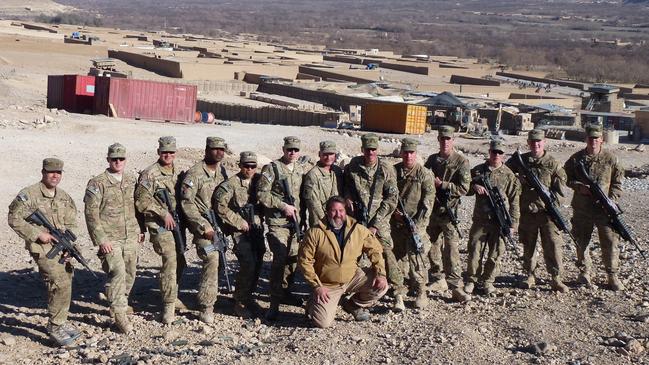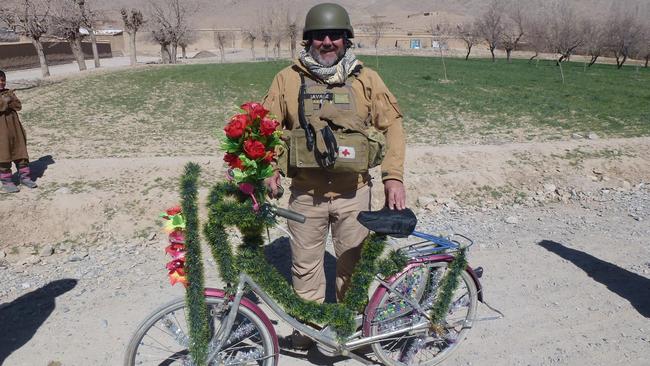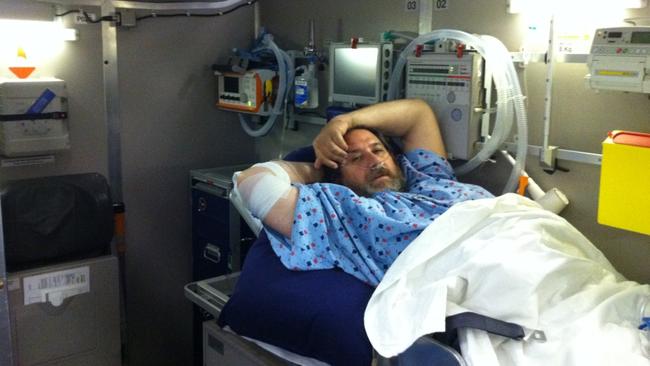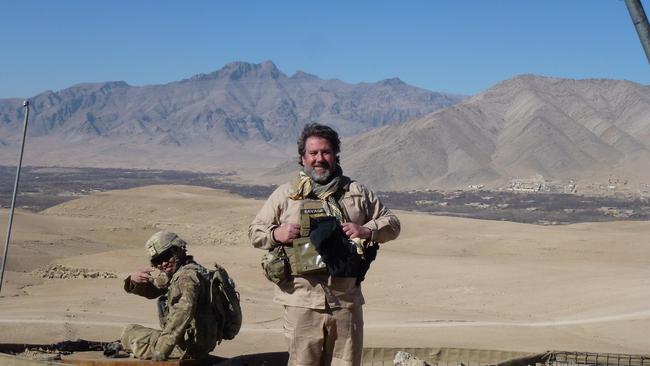The boredom of Canberra nearly killed David Savage. One minute he was in the Department of Foreign Affairs and Trade headquarters agreeing to a posting in Afghanistan, the next he was in the Chora Valley, Uruzgan Province, being approached by a child in a suicide bomber’s vest. Those moments were months apart, but they were a one-two punch for Savage and, one way or another, it was Canberra’s fault. When DFAT’s First Assistant Secretary asked Savage whether he’d like a post in Afghanistan, he replied instantly: yes.
Reports, commutes, meetings, coffee breaks – this was a drudgery to which he found himself allergic. Savage was in his late 40s but this was his first office job, having previously worked for the Australian Federal Police’s Special Operations Unit and the United Nations as a war crimes investigator in Afghanistan. He’d had desks before, but he hadn’t had to spend much time behind them. Now he was finding the groundhog days of office life mind-numbing and soul-crushing. So when he was asked to take on a civilian reconstruction role in Afghanistan, he said yes before his bored mind had properly registered the request.
He and two other public servants, both of whom had experience in Afghanistan, were to report for initial general Australian Civilian Corps training, which, Savage says, he was surprised to find was to be conducted by Defence personnel. Savage had a strong suspicion that the course was at least partially a recruitment tool for the Defence Intelligence Organisation, and was disappointed to find that he wouldn’t be taught much that would be useful in the field.
After that initial training the men conducted country-specific training, but there was no one to train them except one “subject matter expert” who had spent only four days in Afghanistan, all of them in Tarin Kot, the former Australian military base. Combined, the three public servants heading to Afghanistan had years of on-the-ground experience in the country, and fluency in at least two of Afghanistan’s languages, so they excused themselves from their subject matter briefings and “ended up having three weeks of sitting around, drinking coffee and reading [diplomatic] cables with no context”.
The three men flew to Al Minhad Air Base in the UAE, Australia’s permanent staging base into Afghanistan and the Middle East, and from there to Tarin Kot as “stabilisation advisers”. None of the men knew exactly what that job entailed, but hoped someone would enlighten them before they were sent out into the field. In Tarin Kot they found they were, by and large, the oldest people on a base full of development and political advisers just out of university, many of whom were on their first posting; some had never even left Australia before. On the afternoon they arrived in Tarin Kot they were given their one and only specific briefing – by a man in his early 20s who was on his first posting. “He stood in front of a map of Uruzgan with a pointer, saying, ‘These are the Barakzai and this is the Popalzai, and these guys hate these guys, and these guys hate these guys, and this and this, and… you got that?”’ says Savage. The briefing went for about half an hour, and the stabilisation advisers were given no materials to take away and no direction to a place to access further information. After the briefing, the men were told to prepare to move into their bases early the next morning. One man was staying in Tarin Kot and one was off to Patrol Base Razaq in Deh Rawood. Savage was going to Forward Operating Base (FOB) Mirwais in the Chora Valley.
A dozen hours later, with all of his gear, armour and helmet, Savage scrambled into a US Chinook helicopter that was doing a mail run. “Mirwais?” he yelled at the loadmaster. A thumbs-up followed. The helicopter landed and took off and landed and took off, pepper-potting across Uruzgan, until finally Savage was the only passenger left. They flew north and descended towards a remote, rocky outcrop near a tiny base. The US loadmaster yelled into Savage’s ear: “When we land, you grab your gear and run like f..k. You’re in ‘Injun country’ now!” The helicopter touched down, and as the spitting dust settled, Savage struggled and strained, with all of his equipment, towards a large and foreboding steel gate. “Who the f..k are you?” was his greeting from the Green Beret who opened it. This was not FOB Mirwais but FOB Anaconda, the base from which the SASR had launched its 2008 missions in Khas Uruzgan.
Savage was then ferried on to FOB Mirwais, a small forward base just above the Chora green belt, only a few hundred metres from the base of Koran Ghar where, just a few years earlier, Ben Roberts-Smith, Matthew Locke and Kilo-2 had nearly been overrun. Savage was to be the only civilian in a military compound that was a world away from Camp Russell, where SASR operators ate steak and lobster at dinner and drank frothies at the Fat Lady’s Arms.
Mirwais, like most of the forward bases, was spartan. The Australian soldiers lived with Afghan recruits, sometimes surviving on cold ready-to-eat meals and sleeping on the ground. Mirwais sometimes experienced indirect attacks, but Chora was not what it had been five years earlier. Gone were the insurgents manning fixed fighting positions and trenches in open daylight. This was, in no small part, due to the district of an estimated 50,000 people – roughly the population of Queanbeyan – being lavished with money, a lot of it Australian taxpayers’ money. Much of it was spent on unsustainable projects that benefited the insurgency, but as long as the money flowed, some level of stability could be maintained.

Savage says he learnt how to be a stabilisation adviser by picking up the reconstruction ventures already in progress, which he describes as “all kinds of f..ked-up projects”. One was a dam that had been commissioned between two nearby villages, neither of which wanted it, as they both had access to a permanent water source that had to be diverted to fill the dam. The villagers were blocking the filling of the dam, and Savage found that the local contractor who had built it couldn’t be paid until it had been filled. The contractor told him he had offered a $20,000 bribe to the police chief so that he could complete his work, and he was desperate to pay off his bribe debt before he felt the police chief’s ire. Until the dam was completed, there were all kinds of potentially violent flashpoints for which the Australian forces might be blamed, so more money was found to give to the obstinate villagers so the dam could be filled, the contractor compensated and the bribe to the police chief paid. Today, Savage says he is sure that the dam was emptied immediately after it was filled and was likely never used.
There was also a nearby health centre, paid for by the Australian government, that was collapsing. Savage found the contractor who had built the centre, and the man said he wasn’t surprised that the building was collapsing as he was a well digger and had never built a building before. The contractor said he had stressed this fact often as he was being commissioned. Also in progress was the construction of a two-storey market building called the Caravanserai, paid for primarily by the German government, which, at the opening of the project, said it would be “built with materials like clay, based on engineering principles that mean it will last 20 years. It’s very well built.” That too was already collapsing before it was finished.

Savage was tasked with moving local shopkeepers from shops they owned and into the Caravanserai, where they would have to pay rent, but it was already starting to look like an ice-cream cake in the sun. “They’d ask why they would want to move in, and I had no answer,” Savage says. “I don’t know why they would.” There was an answer, however: give them money to move in. Money, during this phase of the war, was the answer to everything. “How much money can I spend?” Savage says he would ask Canberra. “And on what?”
“As much as you need,” they’d answer, according to Savage. “Millions, whatever you need. Just spend.” He says there were no KPIs, no specific goals and no strategy – just spend. And spending money liberally, Savage found, was one of the two primary jobs of a stabilisation adviser. The other was reporting – every day to Tarin Kot; every week, fortnight and month to Canberra – on the great successes of the Australian Civilian Corps. “Everything had to be positive,” he recalls. “Everything. Every activity was a winner; that was clearly the environment they wanted to foster.”
The biggest winner was the $US32 million road that had been constructed between Tarin Kot and Chora. This had been the signature project for the Dutch, and was opened by their state secretary for foreign affairs, Ben Knapen, who came to Uruzgan for the launch. “I came here to see how the local population is building on the foundations put in place with Dutch development assistance,” he said. “What I have seen gives me every confidence.” The road was ceremonially opened and then, within the hour, closed again.
In the original plans for the road, a series of dips and washaways for drainage were to be installed, with the planners knowing culverts would be used by insurgents to plant IEDs. These plans were changed in a rush to finish the road and eventually 120 culverts were built. At the opening ceremony, an IED was detonated in one of these culverts and the officials, including the Dutch minister, had to be helicoptered back to Tarin Kot rather than taking the road. The road attack was blamed publicly on the Taliban, but many believe it was ordered by militia leader Matiullah Khan – Australia’s primary special forces partner – who was being paid to secure the road and had tried to renegotiate his agreement just before the opening.
Savage says Matiullah loomed large over the Chora Valley, ruling in the day as the Taliban ruled at night. Caught in the crushing twilight were a number of villages in the area. Not much more than a kilometre from FOB Mirwais was Niazi, a compound cluster of mostly Ghilzai tribal occupants. This was a village to which the governor had asked Savage to give particular attention. Some locals told Savage that the young men and boys could not be controlled due to, they say, the village elder having been targeted by coalition special forces. It’s not known whether this elder had been targeted by Australian special forces, or if anyone from that village was on the JPEL [Joint Prioritised Effects List, the individuals who coalition forces were trying to capture or kill], but Savage says that while he was at FOB Mirwais there were a number of raids on Niazi. Its people were visited by the Taliban too, often in the form of shabnameh, or threatening night letters, in which they were warned not to engage with the government or the foreigners.
When a new Afghan National Police post to be staffed with Matiullah’s men was built close to Niazi, Matiullah, who had come to Chora for the opening, was outraged that no one from the village had come to celebrate. Savage watched as Matiullah sent his men into Niazi to drag the villagers to the ceremony. He saw them being lined up in front of Matiullah, who was shaking with fury. “He told them that if anyone didn’t do what he told them to do, he was going to cut all their heads off,” says Savage. “He meant it, and I think we all thought he was going to do it.”
Afterwards, more shabnameh came, not only saying they would kill the people of Niazi should they engage further with the government but also that they might kill the Australian who visits their village. Savage says the insurgents were well aware of him as the only Australian civilian in the valley: he was out beyond the wire six days a week with his military escorts, two days with Australian Diggers and four days with US National Guardsmen. Many of the locals believed the Australian civilians who came to the Chora Valley were spies, and this assumption was not completely unfounded. Both ASIS and the Defence Intelligence Organisation had used aid organisations, governmental and non-governmental, as cover for their agents in Uruzgan. Savage says he was accepted by most families and tribes; in fact, he was welcomed, as he was the tap from which the money had been flowing into the valley. He was visible, notable, symbolic. Killing him would change the valley, politically and financially. His killing would be disadvantageous for many, but it only had to be advantageous for one group, or one powerful man, for his life to be potentially forfeit.
Savage believes he was targeted by a local tribal leader known as “Brown Eyes”, who was working with the government but also with the insurgency. He was attacked as he and his American bodyguards were returning from the governor’s compound, where he’d been preparing for the visit of the Australian dignitaries. On their way back to Mirwais, the Americans wanted to stop at a local bakery and buy Afghan bread. As they waited, Savage took photographs of reconstruction projects with a digital camera. The Americans joked and talked about their lives. These men were not like the Australian special forces; they were National Guardsmen, part-timers, with a fraction of the training of the special forces men, and earning a fraction of their money. They had only a fraction of the fight in them, too. Savage liked them, but he considered them boys who had just come into the area. They were not very good at their jobs.
Their forward scout reported that some labourers had fled a building site ahead, leaving their tools behind. This should have created alarm, but the Americans didn’t know what it meant. Savage’s personal bodyguard wandered 20m from his client, and another soldier actually watched the child who was to blow Savage up make his final approach for half a minute, not knowing what he was seeing. What the soldier saw was also seen by his GoPro camera: a prepubescent boy, dressed in a hat and tunic of brilliant white – clothes that denoted the purity needed to enter the green fields of el jannah after martyrdom.

Savage was talking to a US intelligence officer when he was attacked, but was facing away from his assailant. The American saw the bomber, though, just for a moment before the detonation. Savage saw the man’s expression change from mild interest to pure horror. Doctors later said Savage experienced the equivalent of eight shotgun blasts at close range. The pellets in the suicide vest smashed into his back, buttocks and legs, knocking him unconscious. Savage was evacuated to Tarin Kot for surgery but wasn’t expected to survive. Today he has lost the use of his legs and suffers from a mild brain injury. He also suffers psychological trauma and experiences regular nightmares.
A report about the attack prepared by the Australian Defence Force, which had responsibility for Savage, read:
The attack was an unexpected event … the patrol did not detect any threat prior to the PBIED [person-borne improvised explosive device] detonation. More broadly, there had been no intelligence warnings of such a threat. There were no shortfalls in the analysis or provision of intelligence advice or products to the PRT [provincial reconstruction team]. There had been no credible or specific reporting to indicate any likelihood of a [suicide bomb] attack in the Chora district against such a target as the PRT.
Multiple military sources say there were specific warnings about an infiltration of child suicide bombers from Pakistan, but that these warnings were not relayed to Savage or to DFAT.
Edited extract from Find Fix Finish by Ben McKelvey (HarperCollins, $34.99), out now

